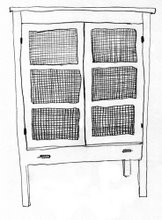Some of the previous challenges have looked difficult, so I was pleased that my first challenge, hosted by Marce at Pip in the City) was Cinnamon and Sticky Buns. I love baking with yeast, so this, to me, was the perfect introduction to the Daring Bakers world.
The recipe was relatively straight-forward and easy but, because it involved yeast, it also involved time. The recipe called for instant yeast, but I only had dry yeast, so I warmed the milk and sprinkled the yeast over, then set it aside for 10 minutes to activate, rather than mixing it at the same time as the flour and milk, as specified in the recipe. I also struggled a little with the conversions from American measurements to Australian. The recipe called for 1 1/8 to 1 ¼ cups of milk. I used 1 Australian cup (250ml) but I think this may have been too much, as my dough was sticky and I needed to add extra flour. However, it didn’t make a difference to the final result. I used my trusty Kitchen Aid to do the kneading for me and the dough rose beautifully in the two hours’ proving time.
The recipe provided information for both cinnamon and sticky buns, so I decided to make half a batch of each. The cinnamon buns are made by sprinkling a mixture of sugar and cinnamon over the dough. Because we were allowed to modify the spices to our taste, I used a mixture of cinnamon, ginger and allspice.
The sticky buns are made the same way but they are then baked in a tray filled with caramel glaze, which adds an extra sweet dimension. The cinnamon buns are delicious but I found them to be a touch dry, so the stickiness of the caramel glaze alleviated the dryness. I wasn’t going to make the fondant icing but the cinnamon buns looked bare and dry without it, so I decided to quickly make a batch. Other Daring Bakers had warned that the quantity was far too much, so I only used 2/3 cup icing sugar with a teaspoon of milk and even this was far too much. The icing was excellent though and enhanced the buns.
I imagined the caramel glaze to be like a thick, hard caramel but it was more like a thick butter icing. The recipe called for corn syrup, which is not used very much in Australian cooking. I actually had a jar in my pantry, as I recently used it in a chocolate cake glaze, but I think golden syrup would make an acceptable substitute. I find corn syrup to have a weird aftertaste but it is strangely addictive.
My husband and family adored these buns, particularly the sticky buns, and they quickly disappeared. The recipe looks long but, broken down in steps, it’s actually quite easy and the results are rewarding. I will definitely be making these buns again. Congratulations to Marce on a great choice of recipe and I’m looking forward to next month’s challenge!
I’ve copied the recipe below as it was published to me, but I’ve added in metric conversions where I can.

Cinnamon and Sticky Buns
(from Peter Reinhart's The Bread Baker's Apprentice)
Days to Make: One (1)
Active/Resting/Baking Time: 15 minutes to mix, 3 1/2 hours fermentation/shaping/proofing, 20 - 40 minutes to bake
Recipe Quantity: Eight(1) - twelve (12) large rolls or twelve (12) - sixteen (16) small rolls
Making the Dough
Ingredients:
- 6 1/2 tablespoons (3.25 ounces) (95g) granulated sugar
- 1 teaspoon salt
- 5 1/2 tablespoons (2.75 ounces) shortening or unsalted butter or margarine
- 1 large egg, slightly beaten
- 1 teaspoon lemon extract OR 1 teaspoon grated zest of 1 lemon
- 3 1/2 cups (16 ounces) (455g) unbleached bread or all-purpose flour
- 2 teaspoons instant yeast*
- 1 1/8 to 1 1/4 cups whole milk or buttermilk, at room temperature OR 3 tablespoons powdered milk (DMS) and 1 cup water
- 1/2 cup cinnamon sugar (6 1/2 tablespoons granulated sugar plus 1 1/2 teaspoons ground cinnamon, or any other spices you want to use, cardamom, ginger, allspice, etc.)
- White fondant glaze for cinnamon buns or caramel glaze for sticky buns (at the end of the recipe.)
- Walnuts, pecans, or other nuts (for sticky buns.)
- Raisins or other dried fruit, such as dried cranberries or dried cherries (for sticky buns, optional.)
Step 1 - Making the Dough: Cream together the sugar, salt, and shortening or butter on medium-high speed in an electric mixer with a paddle attachment (or use a large metal spoon and mixing bowl and do it by hand).
Note: if you are using powdered milk, cream the milk with the sugar, and add the water with the flour and yeast.
Whip in the egg and lemon extract/zest until smooth. Then add the flour, yeast, and milk. Mix on low speed (or stir by hand) until the dough forms a ball. Switch to the dough hook and increase the speed to medium, mixing for approximately 10 minutes (or knead by hand for 12 to 15 minutes), or until the dough is silky and supple, tacky but not sticky. You may have to add a little flour or water while mixing to achieve this texture. Lightly oil a large bowl and transfer the dough to the bowl, rolling it around to coat it with oil. Cover the bowl with plastic wrap.
Step 2 - Fermentation: Ferment at room temperature for approximately 2 hours, or until the dough doubles in size.
Step 3 - Form the Buns: Mist the counter with spray oil and transfer the dough to the counter. Proceed as shown in the photo below for shaping the buns.
(A) Roll out the dough with a rolling pin, lightly dusting the top with flour to keep it from sticking to the pin. Roll it into a rectangle about 2/3 inch thick and 14 inches wide by 12 inches long for larger buns, or 18 inches wide by 9 inches long for smaller buns. Don´t roll out the dough too thin, or the finished buns will be tough and chewy rather than soft and plump.
(B)Sprinkle the cinnamon sugar over the surface of the dough and (C) roll the dough up into a cigar-shaped log, creating a cinnamon-sugar spiral as you roll. With the seam side down, cut the dough into 8 to 12 pieces each about 1 3/4 inches thick for larger buns, or 12 to 16 pieces each 1 1/4 inch thick for smaller buns.)




Step 4 - Prepare the Buns for Proofing:
· For cinnamon buns: line 1 or more sheet pans with baking parchment. Place the buns approximately 1/2 inch apart so that they aren´t touching but are close to one another.
· For sticky buns: coat the bottom of 1 or more baking dishes or baking pans with sides at least 1 1/2 inches high with a 1/4 inch layer of the caramel glaze. Sprinkle on the nuts and raisins (if you are using raisins or dried fruit.) You do not need a lot of nuts and raisins, only a sprinkling. Lay the pieces of dough on top of the caramel glaze, spacing them about 1/2 inch apart. Mist the dough with spray oil and cover loosely with plastic wrap or a food-grade plastic bag.
Step 5 - Proof the Buns: Proof at room temperature for 75 to 90 minutes, or until the pieces have grown into one another and have nearly doubled in size. You may also retard the shaped buns in the refrigerator for up to 2 days, pulling the pans out of the refrigerator 3 to 4 hours before baking to allow the dough to proof.
Step 6 - Bake the Buns:
· Preheat the oven to 350°F (175°C) with the oven rack in the middle shelf for cinnamon buns but on the lowest shelf for sticky buns.
· Bake the cinnamon buns for 20 to 30 minutes or the sticky buns 30 to 40 minutes, or until golden brown. If you are baking sticky buns, remember that they are really upside down (regular cinnamon buns are baked right side up), so the heat has to penetrate through the pan and into the glaze to caramelize it. The tops will become the bottoms, so they may appear dark and done, but the real key is whether the underside is fully baked. It takes practice to know just when to pull the buns out of the oven.
Step 7 - Cool the buns:
· For cinnamon buns, cool the buns in the pan for about 10 minutes and then streak white fondant glaze across the tops, while the buns are warm but not too hot. Remove the buns from the pans and place them on a cooling rack. Wait for at least 20 minutes before serving.
· For the sticky buns, cool the buns in the pan for 5 to 10 minutes and then remove them by flipping them over into another pan. Carefully scoop any run-off glaze back over the buns with a spatula. Wait at least 20 minutes before serving.
Toppings for the Buns: White fondant glaze for cinnamon buns
Cinnamon buns are usually topped with a thick white glaze called fondant. There are many ways to make fondant glaze, but here is a delicious and simple version, enlivened by the addition of citrus flavor, either lemon or orange. You can also substitute vanilla extract or rum extract, or simply make the glaze without any flavorings.
Sift 4 cups of powdered sugar into a bowl. Add 1 teaspoon of lemon or orange extract and 6 tablespoons to 1/2 cup of warm milk, briskly whisking until all the sugar is dissolved. Add the milk slowly and only as much as is needed to make a thick, smooth paste.
When the buns have cooled but are still warm, streak the glaze over them by dipping the tines of a fork or a whisk into the glaze and waving the fork or whisk over the tops. Or, form the streaks by dipping your fingers in the glaze and letting it drip off as you wave them over the tops of the buns. (Remember to wear latex gloves.)
Caramel glaze for sticky buns
Caramel glaze is essentially some combination of sugar and fat, cooked until it caramelizes. The trick is catching it just when the sugar melts and lightly caramelizes to a golden amber. Then it will cool to a soft, creamy caramel. If you wait too long and the glaze turns dark brown, it will cool to a hard, crack-your-teeth consistency. Most sticky bun glazes contain other ingredients to influence flavor and texture, such as corn syrup to keep the sugar from crystallizing and flavor extracts or oils, such as vanilla or lemon. This version makes the best sticky bun glaze of any I´ve tried. It was developed by my wife, Susan, for Brother Juniper´s Cafe in Forestville, California. NOTE: you can substitute the corn syrup for any neutral flavor syrup, like cane syrup or gold syrup.
- In the bowl of an electric mixer, combine 1/2 cup granulated sugar, 1/2 cup firmly packed brown sugar, 1/2 teaspoon salt, and 1/2 pound (250g) unsalted butter, at room temperature.
- Cream together for 2 minutes on high speed with the paddle attachment. Add 1/2 cup corn syrup and 1 teaspoon lemon, orange or vanilla extract. Continue to cream for about 5 minutes, or until light and fluffy.
- Use as much of this as you need to cover the bottom of the pan with a 1/4-inch layer. Refrigerate and save any excess for future use; it will keep for months in a sealed container.





